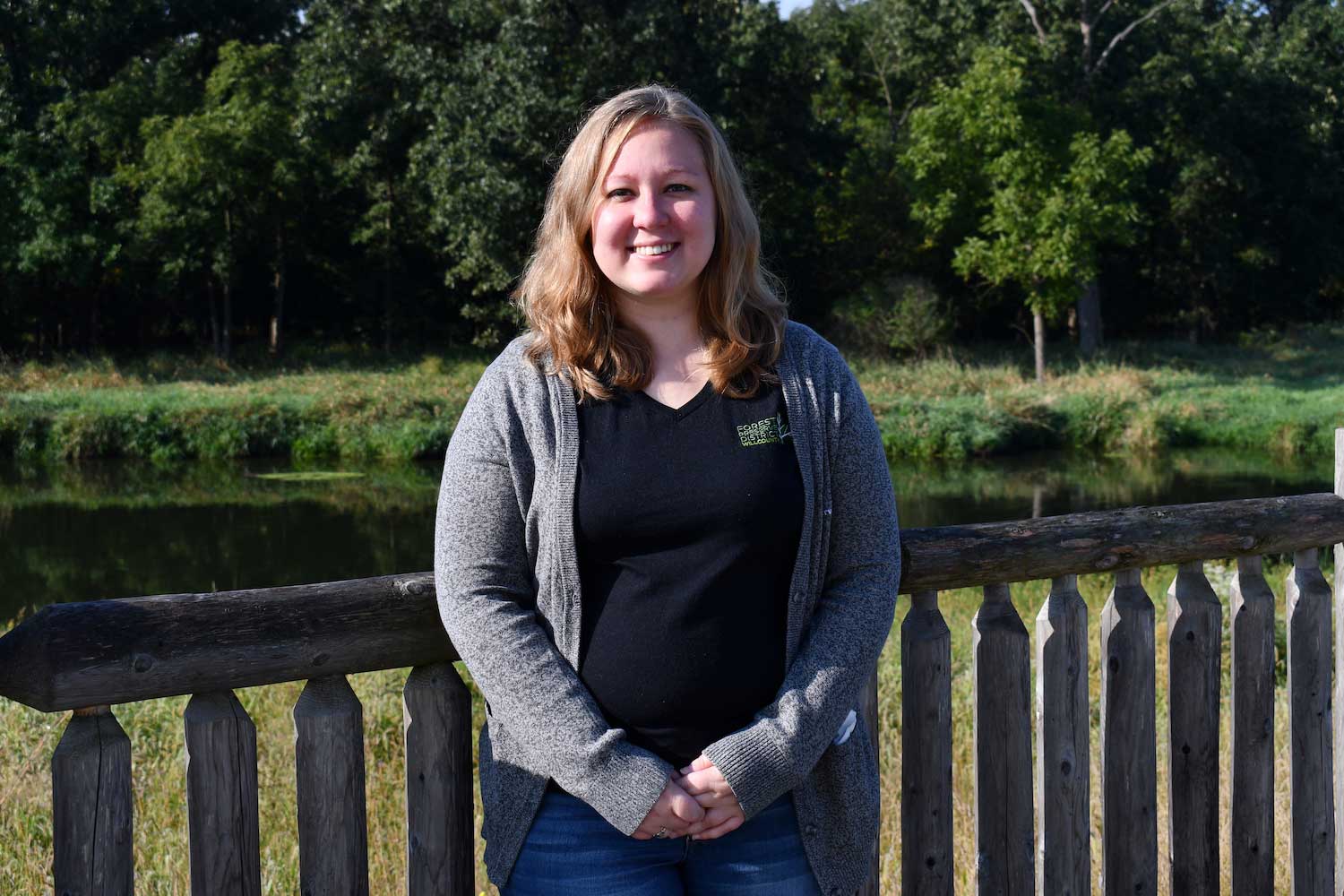Meet a Naturalist: Jenna Krukowski, always curious about the past

Isle a la Cache Museum is unique among the Forest Preserve’s visitor centers because our region’s cultural history is at the forefront. For a historian like Jenna Krukowski, it allows a perfect opportunity to put her skills to good use while also expanding her knowledge base.
Krukowski, an interpretive naturalist at Isle a la Cache Museum, said being able to combine cultural history with natural history is one of the most unique aspects of the job. Her background is in history, and since starting with the Forest Preserve in 2022, she’s been rapidly expanding her knowledge of Will County’s natural history.
“This is definitely the most fun job I’ve ever had,” she said. “For me, obviously I don’t have a background in any sort of environmental things, so it’s definitely been a constant learning curve.”
While history has been the focus of her studies and professional career, spending time in nature isn’t exactly new to her, however.
“I’ve always had an interest in nature. I grew up going to the Little Red Schoolhouse,” she said. “That was someplace I went to religiously growing up. I think there was always an interest in natural history, but it wasn’t until I started working here that I put those two together.”
One of the things she enjoys about working for the Forest Preserve is that she is able to focus on both, and sometimes the two even become intertwined. She’s led programs on the history of taxidermy and how people in the 1800s used nature in their everyday lives, among others, and sometimes learning more about recreation and the natural world enhances her understanding of the people who called this area home in previous centuries.
“I think our jobs are really interesting too because we have such a rich history, and this whole idea of environmental education and interpretation didn’t just start a decade or two ago,” she said. “This started at the end of the 1800s, and we’ve just been trying to educate people ever since.”
Krukowski said she enjoys studying history because it is a chance to “step into another world.” Learning about the past also helps people in the present make connections to those who lived long before them.
“We think of the past in terms of nostalgia. I think taking a step beyond that and learning people’s stories, I just think it makes for better human connection overall,” she said. “Stories repeat, themes repeat throughout time. Something someone is hoping for today is something somebody hoped for 100 years ago.”
Hosting students on field trips is an important part of the job, and one where Krukowski gets to dress the part. When students visit, the interpretive naturalists get into character as voyageurs from 18th-century Illinois Country.
For Krukowski, this was something she looked forward to once she started the job. Her character is a young woman named Genevieve, and she’s still working on honing some of the finer details of who she was.
“The more I learn, the more I try to incorporate things into her character,” she said, adding that interpretive naturalists try to be authentic and respectful of the people of the time they are representing. “I am still fleshing things out, and I think I will be the entire time I am here.”
When working with young kids, the first step is helping them step back into a time so different from the world they live in today.
“The challenge with the school-age population is getting them in context and having an idea of what we are talking about,” she said.
Even with older audiences, teaching our region’s history often moves people beyond their basic understanding of the past. She said she tries to understand where people are coming from so she can help them grow their knowledge.
Krukowski also leads many of the crafting programs at the museum. Crafting is a hobby of hers, and she enjoys being able to use her skills while also promoting the Forest Preserve’s mission and guiding principles.
“I just think (crafting) is a good way to sit down and unwind but also connect with other people,” she said, adding she plans many of her crafting programs to tie into nature or conservation.
Crafting programs are another way to bring people into the museum who may not attend a program or visit otherwise, she said, adding that the programs often include a mix of new faces as well as those who have attended other similar programs.
One of the reasons she enjoys working for the Forest Preserve is because it provides more opportunities that allow her to grow in her role. “I wouldn’t have gotten kayak training at a traditional museum, but it’s good to have that experience because you can relate it to history, like in voyageur programs. It helps with the story telling aspect too. We aren’t just pigeonholed into talking about history or talking about nature.”
Being able to explore both the past and present worlds allows for a fuller understanding of life in both eras as well, she said.
“History and nature are an interwoven story,” she said. “The more you know about both, the better you can understand what is happening today.”
About this series: The Forest Preserve's program coordinators, recreation coordinator and interpretive naturalists are among the friendly faces that greet you when you visit any of our visitor centers and preserves. They are the men and women who lead the District's public programs as well as educational and recreational programs held in the preserves and beyond. They are the people who pique your curiosity and answer your queries, and we want you to get to know more about them and what drives them.
